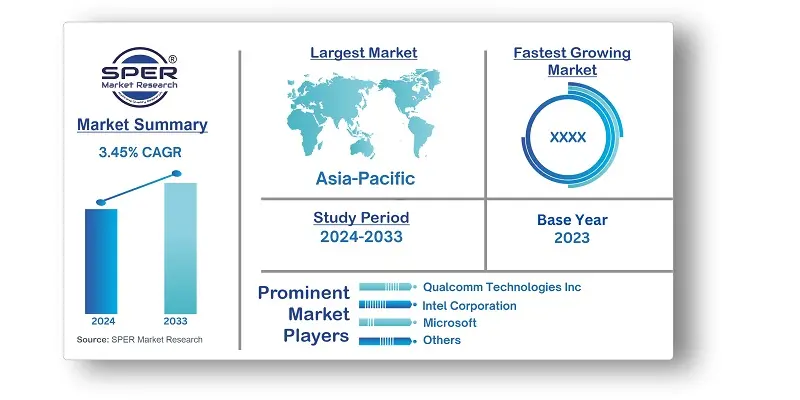
Asia Pacific Wi-Fi Chipset Market Growth, Size, Trends, Demand, Share, Revenue and Future Outlook
Asia Pacific Wi-Fi Chipset Market Size- By Device, By Band, By Fabrication Technology, By Wi-Fi Standard, By MIMO Configuration, By End User- Regional Outlook, Competitive Strategies and Segment Forecast to 2033
| Published: Aug-2024 | Report ID: IACT24150 | Pages: 1 - 157 | Formats*: |
| Category : Information & Communications Technology | |||
- The Wi-Fi Alliance formally launched the Wi-Fi CERTIFIED 7 programme in January 2024, allowing end-user devices such as smartphones, following the introduction of several chips and devices that enabled Wi-Fi 7. Consequently, "Wi-Fi 7 ready" devices will now have the official ability to support the new standard.
- In October 2022, Aglobal, a global leader in IoT platforms and cloud computing solutions, and MediaTek, a chip maker, formed a strategic cooperation to deliver 5G and Wi-Fi router solutions.


| Report Metric | Details |
| Market size available for years | 2020-2033 |
| Base year considered | 2023 |
| Forecast period | 2024-2033 |
| Segments covered | By Device, By Band, By Fabrication Technology, By Wi-Fi Standard, By MIMO Configuration, By End User |
| Regions covered | China, Japan, India, South Korea, Australia, Indonesia, Others |
| Companies Covered | Intel Corporation, Qualcomm Technologies Inc, ESPRESSIF SYSTEMS (SHANGHAI) CO. LTD, Broadcom, Hitachi, Cisco Systems. Inc, Microsoft, Apple Inc, Celeno Communications, Taiwan Semiconductor Manufacturing Company Limited, STMicroelectronics. |
- Telecommunications Companies
- Consumer Electronics Manufacturers
- Automotive Industry
- Internet of Things (IoT) Device Manufacturers
- Networking Equipment Manufacturers
- Enterprise Sector
- Healthcare Sector
- Retail and E-commerce
- Educational Institutions
- Public Sector and Government Agencies
| By Device: |
|
| By Band: |
|
| By Fabrication Technology: |
|
| By Wifi Standard: |
|
| By MIMO Configuration: |
|
| By End User: |
|
- Asia Pacific Wi-Fi Chipset Market Size (FY’2024-FY’2033)
- Overview of Asia Pacific Wi-Fi Chipset Market
- Segmentation of Asia Pacific Wi-Fi Chipset Market By Device (Smartphones, Connected Home Devices, Access Point Equipment, PCs, Tablets, Others)
- Segmentation of Asia Pacific Wi-Fi Chipset Market By Band (Single Band, Dual Band, Tri Band)
- Segmentation of Asia Pacific Wi-Fi Chipset Market By Fabrication Technology (FinFET, FDSOI CMOS, Silicon On Insulator, Sige)
- Segmentation of Asia Pacific Wi-Fi Chipset Market By Wi-Fi Standard (802.11n, 802.11ac, Wave 2, 802.11ac, Wave 1, 802.11ax, 802.11ad, 802.11ay, 802.11b, 802.11g, Others)
- Segmentation of Asia Pacific Wi-Fi Chipset Market By MIMO Configuration (MU-MIMO, 4x4 MU-MIMO, 8x8 MU-MIMO, SU-MIMO, 3x3 MU-MIMO, 2x2 MU-MIMO, 1x1 MU-MIMO)
- Segmentation of Asia Pacific Wi-Fi Chipset Market By End User (Consumer, Automotive and Transportation, Healthcare, Education, BFSI, Travel and Hospitality, Others)
- Statistical Snap of Asia Pacific Wi-Fi Chipset Market
- Expansion Analysis of Asia Pacific Wi-Fi Chipset Market
- Problems and Obstacles in Asia Pacific Wi-Fi Chipset Market
- Competitive Landscape in the Asia Pacific Wi-Fi Chipset Market
- Impact of COVID-19 and Demonetization on Asia Pacific Wi-Fi Chipset Market
- Details on Current Investment in Asia Pacific Wi-Fi Chipset Market
- Competitive Analysis of Asia Pacific Wi-Fi Chipset Market
- Prominent Players in the Asia Pacific Wi-Fi Chipset Market
- SWOT Analysis of Asia Pacific Wi-Fi Chipset Market
- Asia Pacific Wi-Fi Chipset Market Future Outlook and Projections (FY’2024-FY’2033)
- Recommendations from Analyst
1.1. Scope of the report1.2. Market segment analysis
2.1. Research data source
2.1.1. Secondary Data2.1.2. Primary Data2.1.3. SPER’s internal database2.1.4. Premium insight from KOL’s
2.2. Market size estimation
2.2.1. Top-down and Bottom-up approach
2.3. Data triangulation
4.1. Driver, Restraint, Opportunity and Challenges analysis
4.1.1. Drivers4.1.2. Restraints4.1.3. Opportunities4.1.4. Challenges
4.2. COVID-19 Impacts of the Asia Pacific Wi-Fi Chipset Market
5.1. SWOT Analysis
5.1.1. Strengths5.1.2. Weaknesses5.1.3. Opportunities5.1.4. Threats
5.2. PESTEL Analysis
5.2.1. Political Landscape5.2.2. Economic Landscape5.2.3. Social Landscape5.2.4. Technological Landscape5.2.5. Environmental Landscape5.2.6. Legal Landscape
5.3. PORTER’s Five Forces
5.3.1. Bargaining power of suppliers5.3.2. Bargaining power of buyers5.3.3. Threat of Substitute5.3.4. Threat of new entrant5.3.5. Competitive rivalry
5.4. Heat Map Analysis
6.1. Asia Pacific Wi-Fi Chipset Market Manufacturing Base Distribution, Sales Area, Product Type6.2. Mergers & Acquisitions, Partnerships, Product Launch, and Collaboration in Asia Pacific Wi-Fi Chipset Market
7.1. Asia Pacific Wi-Fi Chipset Market Size, Share and Forecast, By Device, 2020-20267.2. Asia Pacific Wi-Fi Chipset Market Size, Share and Forecast, By Device, 2027-20337.3. Tablet7.4. Connected Home Devices7.5. Smartphones7.6. PCS7.7. Access Point Equipment7.8. Others
8.1. Asia Pacific Wi-Fi Chipset Market Size, Share and Forecast, By Band, 2020-20268.2. Asia Pacific Wi-Fi Chipset Market Size, Share and Forecast, By Band, 2027-20338.3. Single Band8.4. Dual Band8.5. Tri Band
9.1. Asia Pacific Wi-Fi Chipset Market Size, Share and Forecast, By Fabrication Technology, 2020-20269.2. Asia Pacific Wi-Fi Chipset Market Size, Share and Forecast, By Fabrication Technology, 2027-20339.3. Finfet9.4. FDSOI CMOS9.5. Silicon on Insulator9.6. Sige
10.1. Asia Pacific Wi-Fi Chipset Market Size, Share and Forecast, By Wifi Standard, 2020-202610.2. Asia Pacific Wi-Fi Chipset Market Size, Share and Forecast, By Wifi Standard, 2027-203310.3. 802.11AY10.4. 802.11AD10.5. 802.11AX10.6. 802.11AC10.7. WAVE 110.8. 802.11AC10.9. WAVE 210.10. 802.11B10.11. 802.11G10.12. 802.11N
11.1. Asia Pacific Wi-Fi Chipset Market Size, Share and Forecast, By MIMO Configuration, 2020-202611.2. Asia Pacific Wi-Fi Chipset Market Size, Share and Forecast, By MIMO Configuration, 2027-203311.3. SU-MIMO11.4. MU-MIMO11.5. 1X1 MU-MIMO11.6. 2X2 MU-MIMO11.7. 3X3 MU-MIMO11.8. 4X4 MU-MIMO11.9. 8X8 MU-MIMO
12.1. Asia Pacific Wi-Fi Chipset Market Size, Share and Forecast, By End User, 2020-202612.2. Asia Pacific Wi-Fi Chipset Market Size, Share and Forecast, By End User, 2027-203312.3. Consumer12.4. Automotive12.5. Transportation12.6. Healthcare12.7. Education12.8. BFSI12.9. Travel12.10. Hospitality12.11. Others
13.1. Asia Pacific Wi-Fi Chipset Market Size and Market Share
14.1. Asia Pacific Wi-Fi Chipset Market Size and Market Share By Region (2020-2026)14.2. Asia Pacific Wi-Fi Chipset Market Size and Market Share By Region (2027-2033)14.3. China14.4. Japan14.5. India14.6. South Korea14.7. Australia14.8. Indonesia14.9. Others
15.1. Intel Corporation
15.1.1. Company details15.1.2. Financial outlook15.1.3. Product summary15.1.4. Recent developments
15.2. Qualcomm Technologies. Inc
15.2.1. Company details15.2.2. Financial outlook15.2.3. Product summary15.2.4. Recent developments
15.3. ESPRESSIF SYSTEMS (SHANGHAI) CO LTD
15.3.1. Company details15.3.2. Financial outlook15.3.3. Product summary15.3.4. Recent developments
15.4. Broadcom
15.4.1. Company details15.4.2. Financial outlook15.4.3. Product summary15.4.4. Recent developments
15.5. Hitachi
15.5.1. Company details15.5.2. Financial outlook15.5.3. Product summary15.5.4. Recent developments
15.6. Cisco Systems, Inc
15.6.1. Company details15.6.2. Financial outlook15.6.3. Product summary15.6.4. Recent developments
15.7. Microsoft
15.7.1. Company details15.7.2. Financial outlook15.7.3. Product summary15.7.4. Recent developments
15.8. Apple Inc
15.8.1. Company details15.8.2. Financial outlook15.8.3. Product summary15.8.4. Recent developments
15.9. Celeno Communications
15.9.1. Company details15.9.2. Financial outlook15.9.3. Product summary15.9.4. Recent developments
15.10. Taiwan Semiconductor Manufacturing Company Limited
15.10.1. Company details15.10.2. Financial outlook15.10.3. Product summary15.10.4. Recent developments
15.11. STMicroelectronics
15.11.1. Company details15.11.2. Financial outlook15.11.3. Product summary15.11.4. Recent developments
15.12. Others
SPER Market Research’s methodology uses great emphasis on primary research to ensure that the market intelligence insights are up to date, reliable and accurate. Primary interviews are done with players involved in each phase of a supply chain to analyze the market forecasting. The secondary research method is used to help you fully understand how the future markets and the spending patterns look likes.
The report is based on in-depth qualitative and quantitative analysis of the Product Market. The quantitative analysis involves the application of various projection and sampling techniques. The qualitative analysis involves primary interviews, surveys, and vendor briefings. The data gathered as a result of these processes are validated through experts opinion. Our research methodology entails an ideal mixture of primary and secondary initiatives.



Frequently Asked Questions About This Report
PLACE AN ORDER
Year End Discount
Sample Report
Pre-Purchase Inquiry
NEED CUSTOMIZATION?
Request CustomizationCALL OR EMAIL US
100% Secure Payment






Related Reports
Our Global Clients
Our data-driven insights have influenced the strategy of 200+ reputed companies across the globe.




















